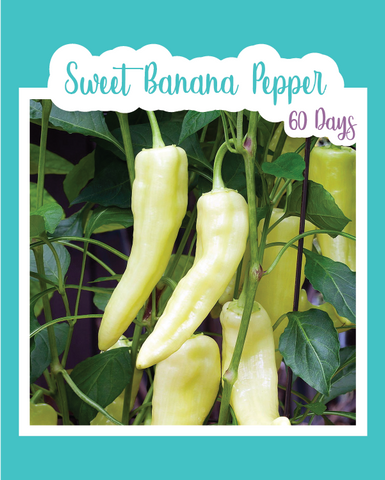
Cubanelle Sweet Pepper
Seed Count: Approx. 25 seeds
Days to Maturity: 80 days
Description: Cubanelle is a long, tapered, 4-6 inch, sweet pepper with thin walls loaded with flavor. Its water content is lower than other bell peppers, so they're a bit crunchier, and boasts flavorful, mildly sweet flesh. Cubanelles are best when picked in their yellow-green immature stage, but are also delicious when used in their mature orange-red stage, as well. This pepper is perfect for roasting or frying, and cooks rather quickly. They can also be used in salads, and casseroles, and on subs, and pizza. These versatile peppers can even be stuffed! Personally, I hate the taste of traditional bell peppers in and on everything, and prefer to use poblanos, cubanelles, or jalapenos instead. Cubanelles grow in imperfect shapes, often twisting or curling a bit, but their vibrant color ranges are gorgeous, adding to this peppers uniqueness. The plants are productive, and grow to around 2 ft. tall.
How To Grow
Sowing: Start pepper seeds indoors in peat pots, about 8 weeks before your last expected spring frost. Sow them 1/4 of an inch deep, and keep the soil at 80-85 degrees F until they germinate. If the soil is too cold it may not germinate. I also find that the hotter the pepper is, the longer those seeds take to germinate. Provide seedlings with adequate sunlight or a grow light for 12-16 hours a day. When the outdoor temperature reaches 60-65 degrees F during the day and no less than 50 degrees F at night, you can transplant your seedlings. Space them about a foot to a foot and a half apart. Exposing the plants to the weather for several hours a day before transplanting may help prevent transplant shock. Peppers grow well in containers or raised beds. These plants are determinate, and I grow mine in 5-10 gallon grow bags. I prefer 10 gallon bags, because I don't have to water them as often, but 5 gallon sized bag works just as well.
Growing: Keep the soil evenly moist and weeds under control. Mulching your plants may help with this. If excess heat and sun cause the plants to wilt, provide shade them with shade and ample water, but be careful not to over water them. Usually my peppers survive my hot summers, so I wouldn't worry much about it, but I have noticed that bell peppers don't tolerate my heat as well, so I shade them during the heat of the afternoon sun. Peppers are prone to blossom end rot, so I always make sure to start them with high amounts of nutrients, so I always mix in powdered egg shells, bone meal, and Epsom salt into the soil. I also feed them with fish emulsion and Fox Farm's Tiger Bloom, once a month, to ensure that I get lots of peppers with none of the rot. My peppers always get plagued with white flies, aphids, and scale, so an organic horticultural spray could be beneficial. Companion plant with basil, coriander, onions, spinach, and tomatoes but do not inter-plant with beans.
Harvesting: When to harvest sweet peppers is basically a matter of personal preference. You can pick them while they are green and immature or when red and mature. Mature peppers will signal the plant to stop producing, so I pick them often. However, my peppers have always been productive, regardless of if I let them mature on the plant or not. Always use a knife or scissors to remove peppers from the plant to prevent damage to their fragile stems. Peppers are extremely versatile and can be used fresh, dried, or for seasoning. You can even make delicious pickled peppers or my favorite fajitas with these peppers. They can be frozen for future use too. If you plan to save seeds, keep in mind that peppers will cross pollinate with other varieties of pepper, including hot peppers, so isolation may be necessary to preserve its genetic purity. Allow peppers to fully mature, then cut them open, and remove the seeds. I give the seeds a little rinse, then I spread out the seeds to dry for about two weeks. Store the seeds in a cool, dry place for up to two years.




